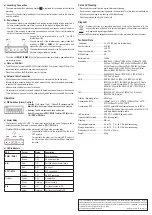
This is a publication by Conrad Electronic SE, Klaus-Conrad-Str. 1, D-92240 Hirschau (www.conrad.com). All rights
including translation reserved. Reproduction by any method, e.g. photocopy, microfilming, or the capture in electronic data
processing systems require the prior written approval by the editor. Reprinting, also in part, is prohibited. This publication
represents the technical status at the time of printing.
Copyright 2018 by Conrad Electronic SE.
*1697438_v1_0818_02_dh_m(2)_en
a) Grounding Connection
• The screw marked with an grounding symbol
is available for connection to the electrical
grounding.
•
Connect it to the electrical grounding of the electrical control cabinet in which the network
switch is installed.
b) Power Supply
- Both sources of power are independent and provide reverse-polarity voltage protection. If
both are connected at the same time, the one with the highest voltage will be used.
- The power supply is designed to be redundant and only requires one source of power to
operate. If two sources of power are connected and one fails, the unit will immediately
switch to the alternative power source.
PW1
PW2
•
Connect the 6-pin terminal block to the 12 - 56 V/DC
terminal input
(4)
.
•
Connect one end of the terminal power supply leads (not
included) to
PWR1
or
PWR2
on the terminal block, and
connect the other end to the power supply.
•
The power leads should be wired to the 6-pin power terminal
block matching polarities as marked.
•
Check the LED
PWR1 / PWR2
(1)
on the front panel to make sure that any powered switches
are receiving power.
c) Place on DIN Rail
•
The DIN rail has to comply with EN 55022 (overall width 3.5 cm, overall height 0.75 cm). The
roduct may not be installed on any other mounting rails!
•
Place the product on the DIN rail and secure it in place.
d) Network Cable Connection
• Use suitable network cables to connect devices and computers to the switch ports.
• All network ports supports auto uplink, which means that no crosslink cables are necessary
to connect multiple network switches.
• Make sure the cables are not bent or crushed.
• We recommend to mark the network cables with suitable adhesive labels or other devices.
This will allow you in case of a fault to know perfectly which connections need to be checked.
Operation
a) DIP Switches (Alarm Control)
•
Switches 1 to 6 (ports 1 to 6). If these DIP switches are ON,
Alm
LED
(6)
will activate if a network connection is severed.
• Switches 7 and 8 are spare and have no function.
•
Switch 9 (power inputs
PW1
/
PW2)
. The
Alm
LED
(6)
will turn
ON if
PW1
or
PW2
fails.
b) Alarm Relay
•
The switch has a single 24 V/DC, 1 A alarm relay output, and can be set to trigger when a
network connection is severed or a source of power (
PW1 / PW2)
fails.
• The
Alm
LED
(6)
will blink and the alarm relay will trigger a few seconds later.
PW1
PW2
ALM
•
To deactivate the alarm, set the related DIP switch to the
OFF position.
•
To reactivate the alarm, set the related DIP switch to
the ON position after the alarm conditions have been
removed.
c) LED Indicators
LED
Colour
Status
Description
PWR1 / PWR2
Green
ON
Receiving power
Green
OFF
No power received
Alm
Red
ON
Port link down or power failure
Red
OFF
No event
SFP1 / SPF2
Green
ON
SFP connected
Green
OFF
No SFP connected
Link/Act
Green
OFF
Link inactive
Green
Flashing
Network activity
PoE
Amber
ON
Port is connected to PD
Amber
Flashing
Port is not connected to PD
Care and Cleaning
•
Disconnect the product from the mains before each cleaning.
•
Do not use any aggressive cleaning agents, rubbing alcohol or other chemical solutions as
they can cause damage to the housing and malfunctioning.
•
Clean the product with a dry, fibre-free cloth.
Disposal
Electronic devices are recyclable waste and must not be disposed of in the
household waste. At the end of its service life, dispose of the product in accordance
with applicable regulatory guidelines.
You thus fulfill your statutory obligations and contribute to the protection of the environment.
Technical Data
Input power ...................................
44 - 57 V/DC via 6-pin terminal block
Number of ports
............................
4 x RJ45
2 x SFP
Power consumption
...................... max. 7 W
MAC address
................................ 2 K
Buffer memory .............................. 128 Kb
Standards ..................................... IEEE 802.3 – 10BaseT, IEEE 802.3u - 100BaseTX, IEEE
802.3ab - 1000BaseT, IEEE 802.3z 1000BaseSX/LX, IEEE
802.3af Power over Ethernet (PoE) IEEE 802.3at Power
over Ethernet (PoE+), IEEE 802.3az - Energy Efficient
Ethernet (EEE), IEEE 802.3x - Flow Control
EMI ...............................................
EMI EN55032 Class A, IEC61000-3-2, IEC 61000-3-3,
FCC Part 15 Class A
EMS ..............................................
EMS IEC61000-4-2 (ESD) Lv.4, IEC61000-4-3 (RS),
IEC61000-4-4 (EFT), IEC61000-4-5 (Surge) Lv.5: Line to
Line 4KV, Line to Ground 6KV at DC-In, Line to Ground
6KV at RJ-45 ports, IEC61000-4-6 (CS), IEC61000-4-8,
IEC61000-4-11
IEC
................................................
IEC60068-2-27 (Shock), EC60068-2-32 (Free Fall),
IEC60068-2-6 (Vibration)
Filtering / forwarding rates ............ 8.93 Mpps
Transmission RJ45
.......................
10BaseT Cat. 3, 4, 5 UTP/STP 100BaseTX Cat. 5 UTP/
STP 1000BaseT Cat. 5E UTP/STP
Transmission SFP
........................
62.5/125 μm Multi Mode Fiber optic cable, up to 220 m
50/125 μm Multi Mode Fiber optic cable, up to 550 m 9/125
μm Single Mode Fiber optic cable
LED indicators
..............................
PW1, PW2, ALARM, PoE and Link/Act
Ingress protection rating ...............
IP30 (housing only)
Mounting .......................................
DIN rail
Operating temperature .................
-40 to +75 °C, 5 – 95 % RH (non-condensing)
Storage temperature .....................
-40 to +75 °C, 5 – 95 % RH (non-condensing)
Dimensions (H x W x D)
............... 55 x 120 x 108 mm
Weight ..........................................
620 g


























